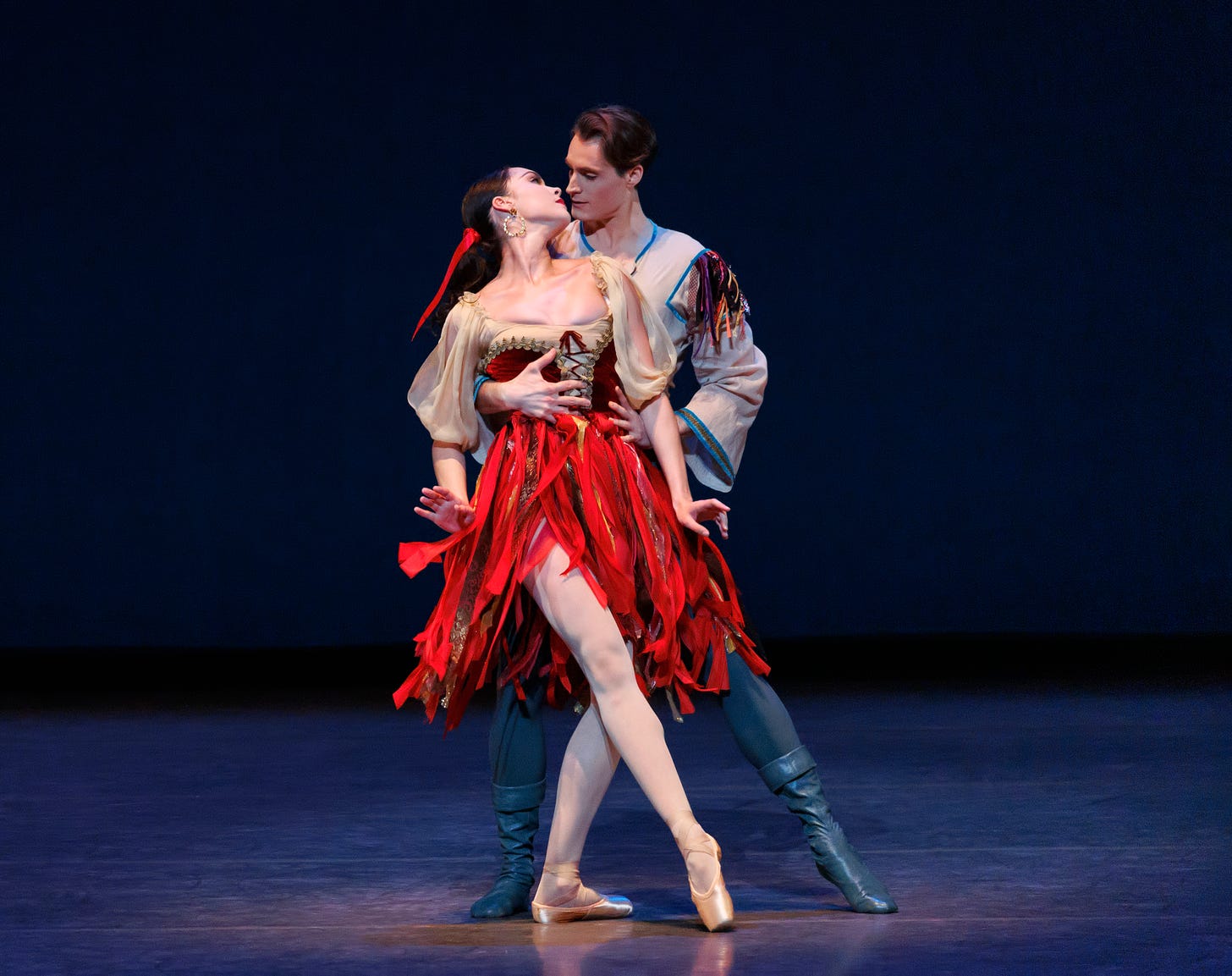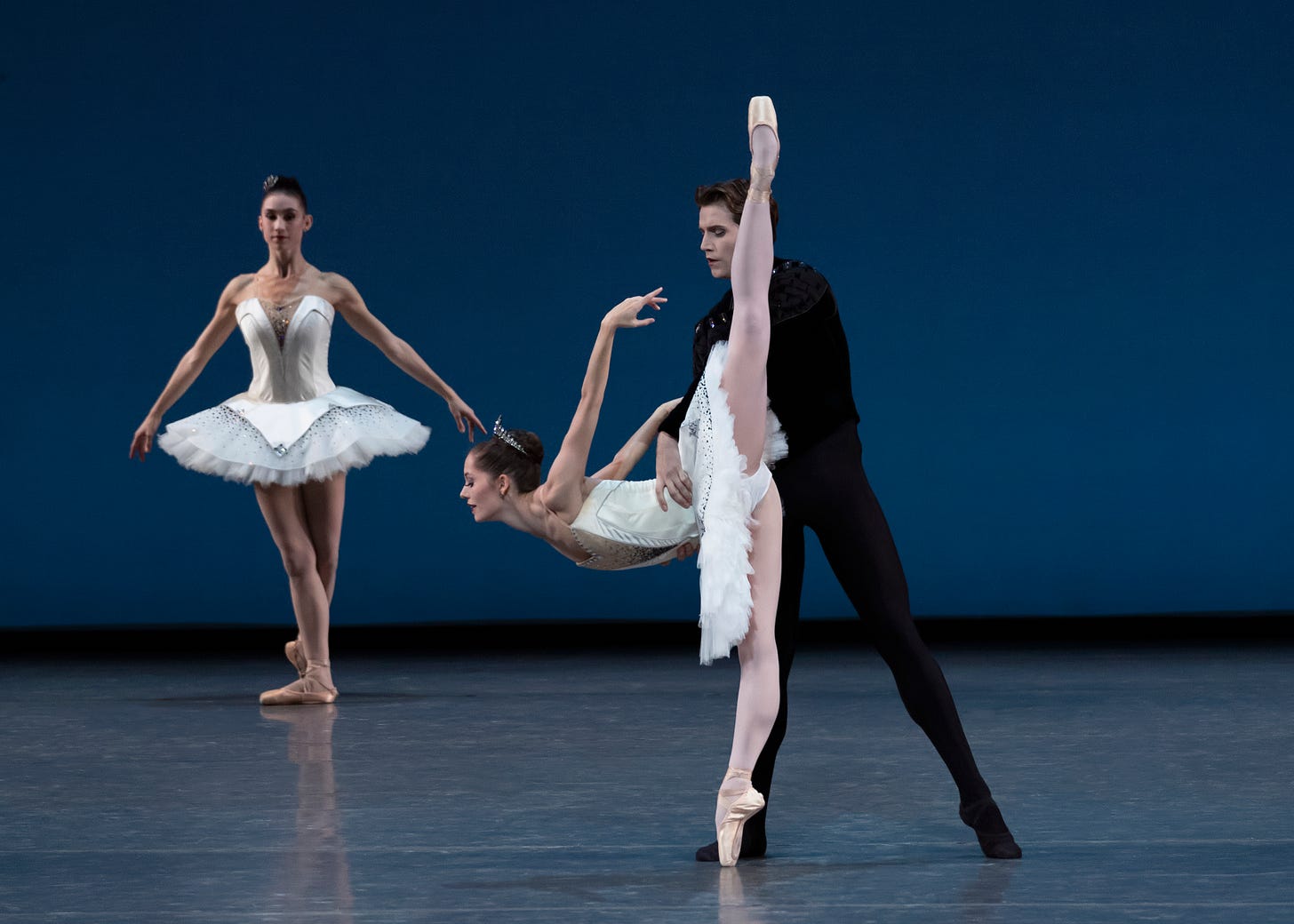New Name, Same Panache
New York City Ballet revives "Tzigane," now called "Errante," a ballet created for Suzanne Farrell
In its usual fashion, New York City Ballet opened its season with ballets by George Balanchine, guardian spirit of the company. The compilation included a couple of rarities: Bourrée Fantasque, which premiered in 1949 and was revived after a long absence last season; and Errante, formerly known as Tzigane, from 1975. They were the centerpiece of an eclectic program that also included the Hans-Christian Andersen bauble The Steadfast Tin Soldier and the grand, sparkling Symphony in C, both set to music by Georges Bizet. The juxtapositions made for awkward contrasts at times, but also, in a funny way, revealed certain resonances. Without seeing Bourrée Fantasque and Symphony in C on the same program, I might never have noticed how similar they are in structure, with different lead casts for each section showing off different temperaments, and a return appearance by all of them in the grand finale, where they interchange steps. Balanchine, like every choreographer, had certain formulas he liked to fall back on.
The most intriguing item on this quadruple bill, and the least like any other, was Errante, made in 1975 for Suzanne Farrell upon her return to the company after years in exile after a bitter falling-out with Balanchine. (For more on that story, see Farrell’s memoir Holding on to the Air, or Jennifer Homans’s more recent Mr. B.) Farrell’s “welcome home” piece is an anomaly in the Balanchine catalogue: a character dance filled with exotic flourishes, meant to show off the personal characteristics of a particular dancer. It's a specialty number in the manner of the colorful interludes that pop up in everything from Don Quixote to Paquita to the opera La Traviata—a sultry folk number meant to evoke the Iberian-slash-Hungarian spirit. In a certain sense, it works against type. This pseudo “gypsy” dance (tzigane means gypsy in French) was made for the dancer that Balanchine referred to as his “alabaster princess,” the tall, fair, pale, remote Farrell.
Mira Nadon in Errante. Photo by Erin Baiano
What makes this slightly preposterous dance work is pairing it with a dancer who can bend it to her own will and physical characteristics. That way it becomes an expression of freedom, as if the dancer were inventing it on the spot. The music is a rhapsody for violin by Ravel in the Hungarian style, composed for a female virtuoso, Jelly d’Aranyi. It contains all the tricks in the virtuoso’s handbook, swooping melodies and slashing chords and trills and glissandi and barely-audible overtones.
For this revival, the first since the early nineties, Farrell coached Mira Nadon as well as Aarón Sanz, who enters the scene about half-way through, introducing a new tone of flirtation and attraction. (The original was Peter Martins.) On the surface, Nadon could not be more different than Farrell, but the two dancers share a sense of abandon and freedom onstage, and both project a powerful magnetism. Both are dancers who know how to use their eyes, and shoulders, and even, it seems, their skin, to give the impression that the music is animating them with its spirit, bewitching them, and thus the audience, entirely.
The choreography, set to bold musical gestures, consists of lunges, unfurlings of the legs, swirls, and luxurious kicks, paired with wild arms and a deep bending of the body at the waist. The dancer uses her legs and arms to cast spells. When the man arrives, he at first keeps his distance. They perform the same movements—who is bewitching whom? She jumps to him, he hooks her leg with his arm; she drapes herself in his arms in a deep backbend and walks blindly forward, in a sultry, over-the-top version of the woman’s serene walk in the ballet Diamonds, created in 1967 for, you guessed it, Suzanne Farrell. When the ensemble arrives, the dance devolves into wild folk romp, full of jumps to the knee, kicks, and stomps. El duende, indeed.
Tzigane worked here not just because Nadon is right for it, but also because she fully inhabited and understood the role and filled it out to the brim. The collaboration between Nadon and Farrell produced phenomenal results; Nadon’s performance was electric. She added a blithe nonchalance that is very much part of her own performance style—as she danced it, she seemed to simply enjoy being herself.
Mira Nadon and Aarón Sanz in Errante. Photo by Erin Baiano.
This quality worked less well in Bourrée Fantasque, the ballet that opened the evening. Bourrée, which premiered in 1949 and is set to bombastic music by the French composer Emmanuel Chabrier, is an exercise in style and wit. In the first movement, the woman (originally Tanaquil Le Clercq) is a playful coquette with a fan, who toys with a man who is not quite tall enough to handle her (originally Jerome Robbins). She whacks him in the head with her leg in attitude, and he takes it with good cheer, for which he is rewarded with a kiss behind the fan. But the shenanigans—little stumbles and perky pas de bourrées on pointe, followed by flat-footed steps—are all about sparkle and timing, and in this case Nadon’s dancing was too broad, lacking the requisite refinement. The kick to André Zuniga’s head barely registered. And the humor was overblown rather than witty. In fact the dancers in the first movement give the impression of not being quite sure whether the ballet really is that funny, or why they’re dancing it at all.
In the second section, a vaporous, poetic interlude in the style of Emeralds—I love the repeated image of two dancers “flying” away from the rest of the corps, and then returning to the flock— Emilie Gerrity looked a little lost and unsure of herself. The finale, a raucous polonaise, all circles and sweeping arms, was like a festive merry-go-round, with bodies rising up into the air like champagne bubbles. Pop, pop.
Unity Phelan and Alec Knight in Symphony in C. Photo by Erin Baiano.
Megan Fairchild and Daniel Ulbricht gave an impeccable rendition of The Steadfast Tin Soldier, in which she channeled Coppélia’s guileless flirtatiousness, and he was the very definition of a tin soldier. The evening closed with a performance of Symphony in C. Though it had its high points, in particular the dancing of Unity Phelan and Alec Knight in the rapturous second movement, and that of Alston McGill in the vivacious fourth movement, overall this luminous, celebratory ballet felt rather flat. The opening section was unfocussed and rushed; the third, led by Baily Jones and KJ Takahashi, rather bland. Even Phelan, despite the gorgeousness of her dancing, seemed to interpret her role moment by moment, rather than weaving it into a continuous whole. In general, the ballet looked as if it needed some quality time in the rehearsal room, sharpening up its edges. The costumes, fluffy white tutus that continually flop up revealing their underside, don’t help. Symphony in C should be like fireworks. But at this performance, they failed to launch.
Megan Fairchild and Daniel Ulbricht in The Steadfast Tin Soldier. Photo by Erin Baiano.







